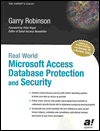databasedev.co.uk - database solutions and downloads for microsoft access
Microsoft Access Articles
- General Microsoft Access Articles
- Microsoft Access 2007 Articles
- Tables
- Queries
- SQL
- Forms
- Reports
- Macros
- Modules & VBA
- Data Models
- Downloads
GUI Design
Resources
Online Shop
Info
Microsoft Access Database Security
Distributing the Secured Database Application
Because permissions are stored with application databases, and accounts and passwords are stored with workgroups, users must have access to both the appropriate databases and workgroups. To make an application database (or databases) and workgroups available to users, you can do any of the following procedures:
- Copy the workgroup information file that defines the workgroup to a network server. Users can join this workgroup by specifying the network server path to the workgroup information file.
- Provide each user with a copy of the workgroup information file that defines the workgroup, so that the users can place it on their local workstation PC. Users can then join the workgroup. One drawback to this method is that if you update the workgroup you must give users separate copies of the updated files.
- If users are using different workgroup information files, you can create the same group account in each workgroup instead of copying the whole workgroup into the file. The common group account must have the same name and personal identifier (PID) in each workgroup. You need to add the users in each workgroup to the common group.
- In all cases, the application files (MDB’s) can be located on a shared network drive or copied to the individual workstations. If a user’s permissions are changed, you need to redistribute a copy of the application database to each PC where that user needs to work.
You might not want to give users a copy of the workgroup information file that defines the workgroup you used when you created the application, because then users might get full permissions to databases and objects (if they can guess a password and log on to Access as members of the Admins group).
Each user must have a copy of Access in order to run your application. If you want users to run an application without having a copy of Access on their computers, you must use the Package And Deployment Wizard included in the MS Office 2000 Developer's Edition. This wizard includes the files necessary to use the run-time version of Microsoft Access. It has its own setup program that you can use to create a custom run-time setup for each user’s computer.
Go to page:
- Steps to Securing an Access Database by Using User-level Security
- Setting Logon Procedures
- Group Accounts
- User Accounts
- Changing a Password
- The Security Wizard
- Permissions
- Testing Security
- Documenting Database Security
- Previewing Permissions
- Securing a Database with a Database Password
- Distributing the Secured Application
Recommended Reading:
If you are serious about your Microsoft Access security, then you should check out Garry Robinson's book Real World Microsoft Access Database Protection and Security
About the book:

Microsoft Access is the most popular desktop database in the world today and its very popularity means that its security measures can be easily compromised. Real World Microsoft Access Database Protection and Security takes a different approach than all the other Access books in the market by focusing from the start on all the issues that will help protect your database. It approaches protection and security from a task-by-task perspective and provides details that when put together will make your database more secure.
This book will help you to keep your staff from looking at your salary tables, stop your customers from looking at the design of your software that you distribute, and help you decide which security options are worth doing and which are generally a waste of your time.
Garry writes from a very experienced developer's point of view and he discusses in detail how to program all types of security issues including hiding tables as system tables, producing databases that password cracker software cannot easily crack, backing-up databases, menus, queries, and even user surveillance.
- Real
World Microsoft Access Database Protection and Security
[From Amazon UK]
- Real
World Microsoft Access Database Protection and Security
[From Amazon US]